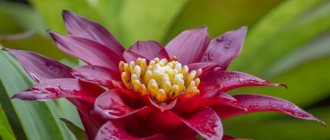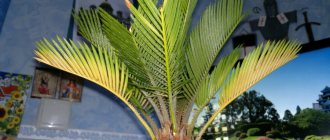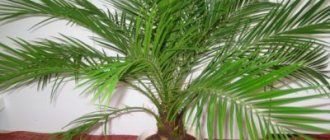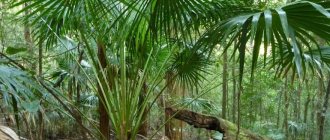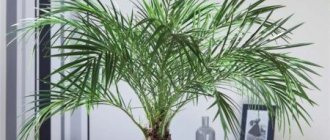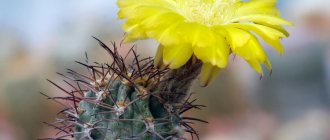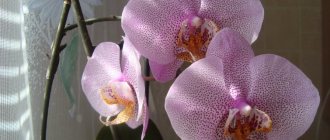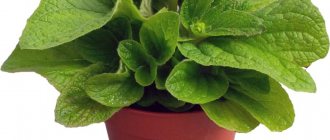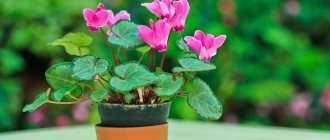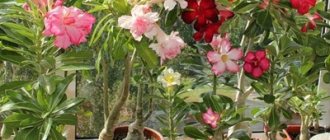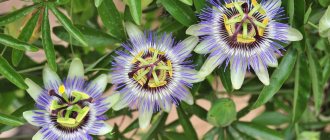The Washingtonia palm is a genus of woody plants in the Palmaceae family. Its homeland is the subtropical regions of Mexico and the United States of America. The palm tree is named after the first US President, George Washington. It has a high growth rate and tolerates mild short-term frosts well. Particularly large specimens grow up to thirty meters in height. The diameter of the feathery leaves reaches one and a half meters. The plant does not shed its old dried leaves for years, forming a kind of “skirt” on the trunk. This material will answer the question of how to care for Washingtonia.
Biological description
Washingtonia is a single-stemmed plant with a spreading fan-shaped crown. The upper part of the gray trunk is entwined with dried leaves and brown felt. The length of the leaf plate is 50 cm. Each palm leaf consists of elongated segments split from the base. The green leaves are hard to the touch. The length of paniculate inflorescences can reach three meters. The palm fruit is a small, dark-colored drupe.
Botanical description and homeland of the plant
Washingtonia is a perennial tree plant of the Arecaceae (Palm) family, named after the first President of the United States.
This is a typical palm tree. The erect trunk reaches a height of 20-30 m, it is almost smooth, but there are scars left by the petioles of dead leaves. At the top of the tree, leaf plates are arranged like fans, cut into separate oblong segments, between which thread-like processes appear. Due to this feature, Washingtonia is also called the cotton palm. By the way, dry leaves remain on the trunk for a long time (gardeners get rid of them to maintain decorativeness) and are a refuge for birds and rodents.
In nature, the palm tree is distributed in the southern United States and western Mexico.
The plant's cold resistance (withstands short-term temperature drops down to -5 °C) allows the palm to be used to decorate parks, streets, and garden plots in regions with mild winters.
At home (this is what the article is devoted to), the Washingtonia palm tree is recently grown. It reveals its decorative effect in cool halls and winter gardens. Mostly young palm trees are grown in the room - up to the age of 7-8 years, in spacious rooms - up to about 15.
Caring for Washingtonia palm at home
Subject to the following rules of agricultural technology, even novice gardeners will be able to grow a healthy and strong tree:
- The plant will be comfortable in a room whose windows face west or east. Washingtonia prefers an abundance of light, but direct sunlight is unacceptable. In the warm season, it is recommended to move the tub outdoors to a slightly shaded place. The palm tree does not tolerate cold winds and drafts.
- In the winter and spring months, the optimal room temperature should be 21-23 °C. Although the palm tree is considered a heat-loving plant, in hot weather, when the thermometer approaches the thirty-degree mark, it must be moved to a cooler place. In winter, during the dormant period, Washingtonia needs ten degrees of heat.
- It is recommended to water with water at room temperature. In summer, water procedures must be carried out as the earthen clod dries out. Excess moisture negatively affects growth and development. Also, do not allow the substrate to dry out.
- In the wild, the tree will grow in subtropical regions with high air humidity, so Washingtonia needs regular spraying. In dry weather, it is recommended to wipe the sheet plate with a cloth soaked in water. The procedure should be carried out in the evening so that the sun's rays do not damage the delicate wet leaves.
- Hygienic pruning is an optional procedure, because the plant does not lose its decorative effect even in the presence of dried leaves. Trimming is carried out only on green leaves.
- It is recommended to enrich the substrate with fertilizers in the summer and autumn months. Complex fertilizers enriched with iron are suitable as fertilizing. It is advisable to fertilize every 2 weeks.
- The substrate for transplanting Washingtonia should consist of 4 components: river sand, turf, leaf humus and humus. A seven-year-old tree can be replanted once every 2 years, and a mature palm tree - once every 5 years. An adult plant needs organic fertilizers.
- For full growth and development, the Washingtonia palm requires a drainage layer consisting of broken bricks, expanded clay or pebbles.
Planting and transplanting
Initially, for a fairly large palm tree, you need to choose a spacious and tall pot in which the root system will develop well. The substrate must be loose, moisture- and breathable, and also contain the necessary nutrients. For planting, you can purchase a ready-made substrate for palm trees or create a soil mixture yourself from turf, humus, leaf soil and sand in proportions 2:2:2:1.
The tree can be replanted at the end of February, or better yet, in early spring. This must be done very carefully using the transfer method, preserving the earthen lump and trying not to damage the roots.
Young plants are replanted with soil renewal every year, 5-year-old palm trees - no more than once every 3-5 years, and mature 10-year-old trees only in case of urgent need, since they do not like to be disturbed. At the same time, in a pot of adult specimens it is necessary to periodically update the top layer of the substrate.
Advice! To speed up germination and increase the percentage of germination, it is recommended to scarify the seeds, that is, artificially break the integrity of the shell with sandpaper or a sharp knife.
Types and varieties of Washingtonia
In our country, gardeners most often grow two types of this plant:
- Washingtonia robusta;
- Washingtonia filamentosa.
Washingtonia robusta (powerful) is native to Mexico, which is why it is often called Mexican. Mature trees are larger in size than Washingtonia filamentosa. The leaves have a rich green color and there are no whitish threads on them. This type is compact. The crown is concentrated in the upper part of the trunk. When grown indoors, the plant tolerates winter well without preparatory measures.
For indoor cultivation, the best variety of Washingtonia powerful, called Santa Barbara, is best suited. This unassuming plant thrives with minimal care. The tree prefers a well-lit area and abundant watering. In the autumn months, the amount of moisture supplied is significantly reduced.
Washingtonia filamentous, or filamentous, came to us from sunny California. In this region there are entire thickets of palm trees. The leaf blade of the Californian fan palm is entwined with white threads. The green leaves have a slightly grayish tint. In winter, this species feels comfortable at temperatures from 7 to 14 degrees Celsius. Washingtonia filamentosa needs plenty of sunlight.
Types of indoor palm trees
Palm trees have been used to decorate interiors in our country for a long time, since the beginning of the 19th century. Of the entire variety of natural species, about 20 are common in indoor floriculture. Depending on the size and shape of the leaves, several groups are distinguished.
Reed
Reed palm
This group of plants has thin stems reminiscent of bamboo shoots with a height of 1 m or more. They are suitable for spacious rooms.
Chamaedorea Seifrizii and Chamaedorea Erumpens have dark green leaves, only the former has narrow leaves, and the latter has wide leaves. Their height can reach 2–3 m.
Cirrus
Palma pinnata
The fronds of plants in this group are divided into leaves, which can be soft and arched or hard and straight.
Fan
fan palm
The large leaves are shaped like segments, fanning out from the base of the leaf blade. The petioles are long, with spines.
Canary date (Phoenix canariensis)
Date canarian
Popular view. It is often offered in garden stores and centers. Growing up, it turns into a large plant with narrow, hard and straight leaves. Unpretentious, he only needs sunlight from the window.
Date Robelena
Does not grow above 2 meters. The lush crown with curved narrow leaves looks very beautiful.
Chamaedorea elegans (Chamaedorea elegans)
Hamedorea gracilis
One of the most common compact types. It is loved by flower growers because it is perfectly adapted to pot growing in small spaces, although in its native Mexico it grows in humid forests. It grows very slowly, reaching only 60 cm in a few years. In good light, yellow flowers appear in adult specimens and fruits are set.
Howea
Hovea
Varieties of this palm tree are shade-tolerant and resistant to pests. Does not lose its decorative effect in dry indoor air. A suitable plant for novice gardeners who want to grow an exotic southern plant for the first time.
Livistona Chinese
Slow growing palm. It is distinguished by large leaves with drooping tips.
Washingtonia filifera
Washingtonia filamentosa
Originally from North America. It can be immediately recognized by the fibers on the edges of the leaves, which in appearance resemble a beard.
Rapis
Rapis tall
An unpretentious Asian palm, drought-resistant. Several species are grown at home: tall rapeseed (Rhapis excelsa), multi-cut rapeseed (Rhapis multifida), as well as popular varieties of tall rapeseed with variegated foliage.
Fishtail Palms (Caryota)
Kariota
Forms graceful low bunches of stems. Green leaves of unusual shape, up to 15 cm long and up to 10 cm wide. They look impressive and are easy to care for.
Growing Washingtonia Palm from Seeds
The tree does not produce lateral shoots, so gardeners grow palm trees from seeds. The seeds are collected after the end of the flowering period, when brown or black drupes with a reddish tint appear on the plant, in which the seeds are located.
Washingtonia Palm Seeds
Washingtonia seeds remain viable for a long time. However, fresh seeds will hatch within a couple of weeks, and old, stale seeds will hatch within 3 months.
The best time for sowing is the last month of winter or the beginning of spring.
To grow palm trees from seeds, a soil mixture consisting of leaf soil, agroperlite and sand is suitable. Perlite and leaf soil can be replaced with steamed moss and sawdust. Experienced agronomists advise adding crushed charcoal. Before planting, the soil is disinfected.
Freshly collected seeds are immediately placed in the ground, while stale seeds must be prepared for sowing. To carry out scarification (violation of the integrity of the shell), it is recommended to process them with sandpaper. The procedure increases the ability of seeds to germinate. Then they are placed in warm water with a growth stimulator dissolved in it. The water temperature should not exceed forty degrees.
The sowing depth of the seeds is about one cm. The seeds placed in the soil are moistened and covered with glass or transparent film. They are periodically removed to prevent the formation of condensation and provide access to oxygen.
Shoots quickly appear in a warm room where the temperature reaches thirty degrees Celsius. Boxes with seedlings can be placed near heating radiators.
Picking is done when full leaves appear. When transplanting into separate containers, you need to act as carefully as possible so as not to damage the fragile root system. Ten-centimeter seedlings are transplanted into a pot with high sides. If there was no picking, then sprouts 1 cm high should be planted in small containers whose diameter does not exceed 7 cm.
At first, Washingtonia grows very slowly. With proper care, a one-year-old plant will have at least 5 leaves. Dissection of the leaf plate occurs when the 8th leaf appears.
After a couple of years, small compact trees grow that adapt well to the environment and have lasting immunity than specimens purchased in stores and nurseries.
Sowing seeds
To sow Washingtonia seeds, you need:
[adsp-pro-4]
- availability of fresh seed. Either purchased or freshly picked;
- carrying out scarification. To do this, carefully cut each seed with a very sharp knife and place in water for 2-7 days;
- prepare a substrate for seeds. Its composition should be as follows: leaf soil, sand, peat (2: 0.5: 0.5)
- pour the seeds onto the prepared soil in a tray, sprinkle with the same soil mixture to a thickness twice the diameter of the seeds;
- create a greenhouse effect by covering with film or glass4
- ensure temperature conditions from 25 to 30 degrees;
- provide regular moisture and ventilation.
The first Washingtonia shoots appear 2-3 months after planting
After two to three months, seedlings should appear. After this moment, the tray with indoor palm tree seedlings is moved to a place with good lighting, but without direct sunlight. As soon as the second leaf appears, Washingtonia indoor seedlings are planted in different containers . The soil in the pots for picking is selected that is specialized for palm plants. You need to start growing Washingtonia seeds in the spring.
Attention: Picking an indoor palm tree should be done very carefully, making sure that the roots all remain intact and the endosperm is not damaged.
There are other options for growing indoor Washingtonia from seeds, which differ in some actions during the growing process:
- You can use peat tablets for germinating indoor Washingtonia, on which one seed is placed and laid out on the soil. Sprinkle with substrate only at the moment when sprouts appear;
- the substrate for germination can be used of a different composition: sawdust, moss, sand (1:1:1);
- Before sowing seeds, both in the soil and in peat tablets, you can resort to the growth stimulator Epin, in which you soak the seeds for 10-12 hours.
We recommend that you familiarize yourself with the information on how to care for ginura at home.
An unusually beautiful gloriosa flower, all the details are at the link
Diseases and pests
| Darkening of leaf tips | indicates a moisture deficiency or potassium deficiency. Regular watering and application of potassium fertilizers will help correct the situation. |
| Change in leaf color | occurs due to dry indoor air. Placing the pot in a container of water and spraying it with a spray bottle will help replenish the lack of moisture. |
| Appearance of spots | This is a reaction to waterlogging of the soil or sudden changes in temperature. It is necessary to refrain from watering for some time and prevent changes in temperature. |
| Formation of dried leaves | this is a natural process. However, the leaves also dry out due to putrefactive lesions of the root system. |
| Scale insects, whiteflies, mealybugs and aphids | the main pests that destroy Washingtonia. In an infected, diseased plant, the leaves begin to curl and become stained. Insecticides are used to get rid of uninvited guests. |
Rules of care
- The lighting should be bright enough. A southern room, a veranda, a balcony - all this is suitable for a tropical miracle. While the plant is small, it needs constant supervision and care, and only when it becomes an adult can the tree grow in a place with less high light levels.
- You need to water the plant regularly, but take into account seasonality. In summer, when the weather is hot, the palm tree needs to be watered once a week. In winter, when it’s cold outside, watering should be reduced and done only when the soil is completely dry. During this period, the tree rests, but still should not be allowed to dry out. This will lead to the inevitable death of the palm tree.
- The air humidity in the room where the palm tree grows should be from 55 to 75 percent. To maintain such humidity, sprayers must be used. In winter, it is also practiced to wash the leaves with a damp cloth.
- As the tree grows, you need to rotate it in relation to the light source. This is necessary for the correct formation of foliage.
Sources
- https://sornyakov.net/komnatnye/vashingtoniya.html
- https://CvetnikInfo.ru/komnatnye-tsvety/palma-vashingtoniya.html
- https://fb.ru/article/259493/vashingtoniya-palma-vyiraschivanie-v-domashnih-usloviyah-foto
- https://flower-fan.ru/palma-vashingtoniya/
- https://dachadizain.ru/cvety/komnatnye/osobennosti-uxoda-za-palmoj-vashingtoniya.html
- https://www.glav-dacha.ru/ukhod-za-palmoy-vashingtoniey/
- https://tsvetydoma.ru/komnatnyie-rasteniya/palmyi/palma-vashingtoniya.html
- https://www.ocvetah.com/flowers/komnatnye/vashingtoniya.html
- https://chvetochki.ru/vashingtoniya/
Washingtonia reviews
Flower growers note that the palm tree is easy to care for and does not cause much trouble. A tree planted in a tub will decorate any interior, making the room more comfortable and lively. Exotic Washingtonia looks spectacular in the winter garden, standing out among other representatives of the flora.
Among the advantages are:
- accelerated growth rates;
- possibility of propagation from seeds;
- decorativeness;
- compactness;
- custom carved leaves;
- unpretentiousness.
Disadvantages include susceptibility to certain diseases; prone to mealybugs, spider mites and plant aphids; large specimens require a lot of space; Is full growth possible at high humidity?
Useful video
Visually familiarize yourself with the features of growing Washingtonia palm trees at home:
Having familiarized yourself with the above materials, you can now make the only right decision for yourself - whether you want to grow or install a Washingtonia palm tree yourself.
Are you ready for some of the difficulties associated with growing and caring for this palm tree? At the same time, remember that such a luxurious plant will completely transform your life and radically change the interior of the room, making it non-standard, “subtropical”.
Interesting Facts
- The palm tree is a symbol of victory, so in ancient times a palm branch was awarded to the winners.
- Colombia and the island of Madagascar hold the record for the number of palm trees growing on their territory.
- In tropical countries, the plant is cultivated as an agricultural crop.
- In dry weather, tree growth occurs only at night.
- Their natural habitat is tropical and subtropical climatic latitudes.
- In the 60s of the last century, archaeologists discovered a pot with palm seeds. Their age was more than 2 thousand years. In the 21st century, scientists tried to grow a tree from them. The attempt was successful, and one of the found seeds sprouted.
Growing
The palm tree is grown in homes and offices as an ornamental plant . It requires special conditions of detention.
- The temperature in spring and summer is 20-25℃, in autumn and winter - 10-12℃.
- Illumination: bright diffused light, daylight hours at least 16 hours.
- Location: windows facing east or west.
- Watering is moderate after the top layer of soil has dried, less often in winter.
- Air humidity should be increased; in summer, the palm tree is sprayed, wiped with a damp sponge, and humidifiers are used; in winter, there is no need to moisten it additionally.
- Feeding: during the growing season from spring to autumn, 2 times a month.
- The dormant period is from late autumn to early spring.
- Replant the plant only if necessary. Young palms up to 7 years old - every two years, then the older, the less often.
- The composition of the soil is humus (you can use peat instead), turf soil, leaf soil, sawdust.
- Washingtonia propagates by seeds.
- Diseases: rotting of roots, yellowing and drying of leaves, appearance of spots on them.
- Pests: whiteflies, scale insects, spider mites.
Reproduction
The Washingtonia palm reproduces by seeds. Seed germination lasts up to five years, but the fresher the seeds, the sooner they germinate. Seeds are planted in the ground in the spring. The soil for this should be loose and consist of 4 parts of garden soil and 1 part of peat and sand.
Seeds can also be germinated in clean sand, sawdust, and peat. The main condition is a loose substrate, this is necessary for unhindered access of air and water.
To quickly germinate seeds, they can be soaked for 10-12 hours in the Epin solution. It’s good if you plant the seeds in peat tablets.
The seeds are buried in the substrate to a depth of 1-1.5 cm, and the container or pot is covered with film. Seeds germinate at a substrate temperature of 25-30C. Washingtonia sprouts from seeds in approximately 20 days.
Strong seedlings are transplanted into pots with a diameter of 7-8 cm. The seedlings grow quite quickly. Young plants are fed with complex mineral fertilizer during growth.
Washingtonia does not reproduce vegetatively; the only way is to sow seeds. With this method, the palm tree grows for a long time, and if you want to quickly have a ready-made plant, you can buy it at a flower shop.
How to take care of palm spear
The spear is the point where new growth occurs in the palm tree. This is the most vulnerable part of the plant. If it has rotted, this could have a number of reasons.
If you apply fertilizer, make sure it is applied to the soil around the plant and not on the spear.
If mold or bacterial infection appears, it usually does not kill the plant. There are many special sprays for treating plants against bacteria.
If the plant is too wet and then exposed to very cold conditions, it can harm the palm tree.
Leaves often turn brown during warm periods after a cold winter. This is a sign that the leaves have not been cared for correctly. Prevention is better than any cure! If this happens, don’t be too upset, new leaves grow every year.
3.Varieties:
3.1.Washingtonia filifera
Slender, elegant palm trees up to 15 m high. The tree trunks are thick, powerful, and carry the remains of old, fallen leaves. The leaves are compound, fan-shaped, reaching a length of 4 m. The petioles of the leaves grow up to 2 m, and in adult plants they have curved spines. The leaf segments are glossy, dark green, reaching a length of 100 - 120 cm. A distinctive feature of this plant is the presence of thin light fibers on the leaves. In its natural environment, during the warm season, the plant forms large, penetrating inflorescences with small, yellowish flowers. After flowering, the flowers turn into small round berries with a diameter of up to 1 cm. In indoor culture, flowering rarely occurs.
3.2.Washingtonia robusta or powerful - Washingtonia robusta
Tall slender palm trees reaching 30 m in height. The trunks are single, gray, with remnants of fallen leaves. In the natural habitat, dried leaf blades often remain under the lush green crown. The leaves are complex, fan-shaped, reach one and a half meters in diameter, and consist of numerous narrow, linear, glossy segments. The leaf petioles grow up to 1 m in length and have sharp spines along the edge. Large, branched, drooping inflorescences grow up to 3 m and bear numerous small orange or yellow flowers. As the flowers ripen, they turn into round black berries up to 8 mm in diameter.
You might also be interested in:
